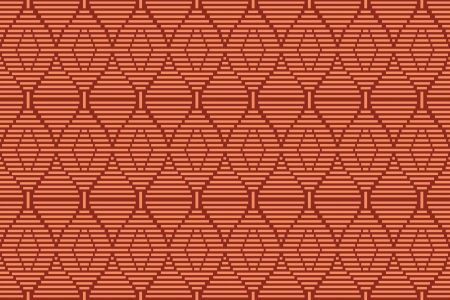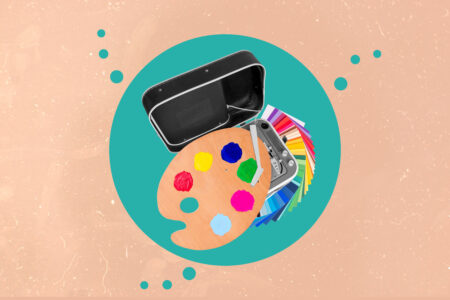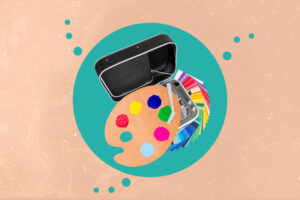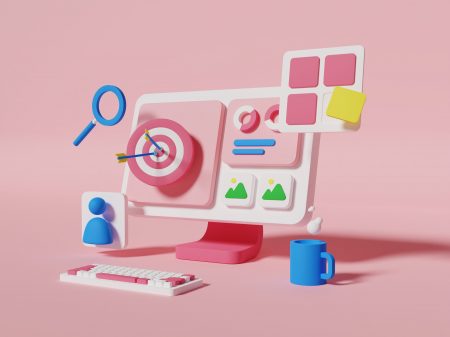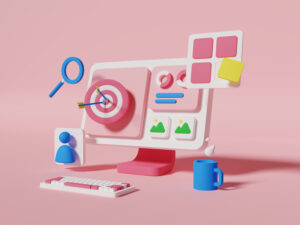Every day, billions of screens light up with visuals crafted by digital graphic designers. From social media posts to website banners and animated ads, these creative graphic designers blend creativity and technology to shape how we experience brands online. They drive innovation in the graphics design industry by mastering digital and graphic design across multiple platforms.
In this guide, you will discover:
- What digital graphic design really means and how it differs from print work
- Core responsibilities and skills that set top designers apart
- Essential tools and emerging technologies, including AI-driven platforms
- Key industry trends, data-driven workflows, and ethical best practices
- Career paths, salary insights, and growth opportunities for 2025 and beyond
Defining Digital Graphic Design
What is digital graphic design?
If you have asked what is digital design, digital graphic design refers to the process of creating visual content for screens. It encompasses website graphics, social media posts, banner ads, and digital branding assets. Designers work with pixels, colors, and typography to deliver engaging visuals. Unlike print, digital graphics must adapt to various devices and resolutions while maintaining file efficiency and load speed.
Difference from traditional graphic design
Traditional graphic design focuses on print deliverables like brochures, posters, and packaging. Digital graphic design differs in key ways:
- Resolution and color mode: Print uses CMYK at fixed DPI, while digital relies on RGB and scalable resolution.
- Interactivity: Digital assets can include animations, hover states, and responsive layouts.
- Workflow and collaboration: Digital projects often involve real-time updates, version control, and cross-functional teams.
Relationship with digital design and UX/UI
Digital graphic design sits within the broader field of digital and graphic design, which also covers user experience and interface structure. While graphic designers craft visual assets, UX/UI professionals focus on usability, information architecture, and user flow.
Digital graphic designers must understand basic UX principles to align visuals with user needs. Close collaboration ensures visuals support interaction goals and maintain brand consistency across digital products.
Core Responsibilities and Key Skills
For creative graphic designers, mastering concept development, composition, and teamwork is crucial to digital graphic designing success.
Concept Development and Ideation
Focus on defining project scope with clients or art directors. Study briefs to set goals. Sketch rough layouts to explore composition, color, and typography. Designers often create mood boards to align color palettes and visual styles early. This work ensures visuals match audience needs and brand identity.
Visual Composition and Branding
Select and arrange images, shapes, and type to craft cohesive assets. Align designs with brand guidelines for websites, social posts, ads, and packaging. Balance hierarchy by adjusting size and contrast to guide the viewer’s eye.
Collaboration, Feedback Loops, and Communication
Work closely with stakeholders, marketing, and development teams. Present design concepts and gather input through structured reviews. Incorporate revisions quickly while tracking version history. Use tools like Figma and Slack to manage feedback and maintain version control. Keep clear updates to ensure projects align with goals.
Key Skills
Hard Skills
- Proficiency in Adobe Photoshop, Illustrator, and InDesign
- Layout design and photo editing
- Understanding of color theory and typography
Soft Skills
- Creative problem solving
- Clear verbal and written communication
- Attention to detail and time management
Essential Tools and Technologies
From classic software to AI-driven platforms, designers use essential tools to streamline digital graphic design and digital graphic designing workflows.
Adobe Photoshop, Illustrator, and InDesign
The Adobe Creative Cloud is the backbone of most design teams. Key applications include:
- Photoshop: Raster editing, compositing, basic video work
- Illustrator: Vector graphics, logos, iconography
- InDesign: Multi-page layouts for digital and print
Generative AI Tools: MidJourney and DALL·E
AI platforms like MidJourney and DALL·E accelerate concept exploration. Designers can:
- Generate custom imagery from text prompts
- Refine ideas before manual editing
- Experiment with styles and palettes in minutes
Prototyping and Collaboration Tools: Figma and Canva
Cloud-based platforms improve team coordination and speed up feedback loops:
- Figma: Real-time prototyping, vector editing, shared design systems
- Canva: Template-driven layouts for social media, presentations, infographics
Industry Trends and Statistics
In this section, we look at the graphics design industry and key graphic design statistics to understand current and future directions.
Market size and growth projections
The global graphic design market tops $60 billion in 2024, rising from $39.8 billion in 2020 and $48.1 billion in 2022. North America accounts for about 40% of that value (roughly $19.65 billion) and is set to grow at a 1.6% CAGR through 2031. In the U.S., the sector will add about 6,600 jobs (2% growth) by 2033, with nearly 21,000 openings each year.
Adoption of AR/VR and interactive media
3D design fuels AR/VR applications for gaming, virtual collaboration, and emerging metaverse platforms. Interactive media now blends task flows, feedback animations, and digital audio enhancements to boost user engagement.
Shifts in remote and freelance work
Freelance designers earn around $45,000 per year on average. Cloud-based tools like Canva enable distributed teams to co-edit assets and streamline workflows. This flexibility allows creative graphic designers to work with clients worldwide.
Ethical and Sustainable Digital Graphic Design
As the graphics design industry evolves, digital and graphic design professionals need to adopt ethical and sustainable practices.
Accessibility standards (WCAG)
Follow WCAG 2.2 guidelines for contrast, keyboard navigation, and alt text. Use semantic headings so screen readers interpret visuals. Clear labels and captions ensure content is readable for all users.
Eco-friendly production methods
Designers can reduce environmental impact across digital and print channels. Even digital assets generate carbon through hosting and transfers, so optimizing performance matters.
Digital workflows
- Compress and optimize images.
- Choose minimalist layouts.
- Host on renewable-energy servers.
Sustainable print
- Use FSC-certified paper.
- Select vegetable inks.
- Limit ink coverage and run size.
Ethical content creation
Ensure imagery and color palettes respect cultural diversity and avoid stereotypes. Review icons and illustrations for bias and inclusivity. Use neutral microcopy and safeguard user privacy in personalized visuals.
Career Paths, Salaries, and Growth Opportunities
A modern graphic designer can pursue various career paths, from specialized niches to freelance work or in-house positions.
Web, Branding, and Motion-Graphics Specializations
Web designers focus on assets for websites and apps, applying responsive layouts and UI fundamentals. Branding specialists develop logos, style guides, and visual identity systems for companies. Motion-graphics designers create animated content for video, social media, and digital ads.
Freelance vs. Corporate Career Tracks
A modern graphic designer can choose between freelance roles or corporate positions, depending on lifestyle and goals.
Freelance Roles
About 18% of designers were self-employed in 2023. Freelancers set their schedules, pitch clients, and adjust workflow. Hourly rates often range from $25 to $100.
In-House Positions
Corporate or agency roles offer a steady salary and benefits. Designers often start near $45,000, then advance to mid-level and senior positions with training and mentorship.
Salary Ranges and Advancement Paths
The median annual wage for graphic designers was $61,300 in May 2024. Mid-level designers can earn $60,000 to $75,000, while senior designers and art directors may exceed $80,000. Career progression can lead to art director, creative director, or chief designer roles. Employment growth is projected at 2% through 2033 with roughly 21,100 openings per year.
Comparing Digital Graphic Design with Graphic Design and Digital Design
When assessing roles, it helps to compare digital graphic design with traditional graphic design and the broader field of digital design. This contrast of graphic design vs digital design clarifies each discipline’s focus and workflow.
Static vs Interactive Media
Traditional graphic design focuses on static print materials like brochures and posters. Digital graphic design outputs include static screen-based assets such as ads and social graphics. In contrast, digital design covers interactive apps and responsive websites that require user interaction and dynamic layouts.
Measurability and User Experience Focus
Digital graphic designers can track clicks, impressions, and engagement through analytics, optimizing visuals post-launch. Traditional print designers lack real-time metrics. Broader digital design adds a deeper emphasis on usability testing, prototyping, and refining user flows based on behavior data.
Workflow and Tool Differences
Workflows also differ. Graphic designers follow a linear path from concept to final output using Adobe Photoshop, Illustrator, and InDesign. Digital design teams work iteratively with tools like Figma, Sketch, or Adobe XD, collaborating closely with developers to test and maintain interactive experiences.
Conclusion
Digital graphic design is more than pixels on a screen—it’s the creative force shaping how audiences connect, communicate, and experience brands in a digital world. Today’s graphic designers do more than just make things look attractive; they unite technology and artistry to deliver visual assets that are dynamic, interactive, and strategically targeted for every platform.
As you’ve seen, the field demands both technical mastery and a thoughtful, human-centered approach. Success isn’t just about knowing the latest software or riding industry trends; it’s about understanding user behavior, collaborating across teams, and measuring the impact of each visual choice

